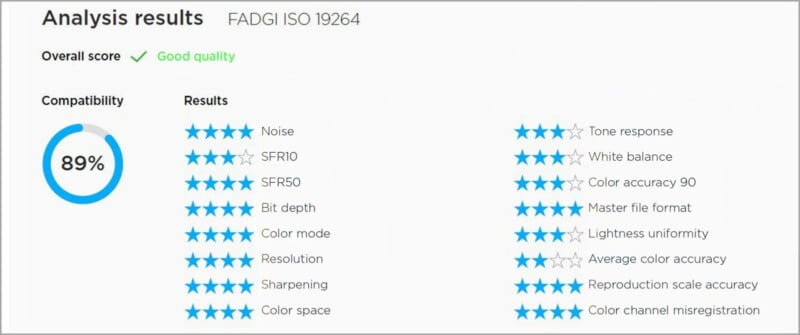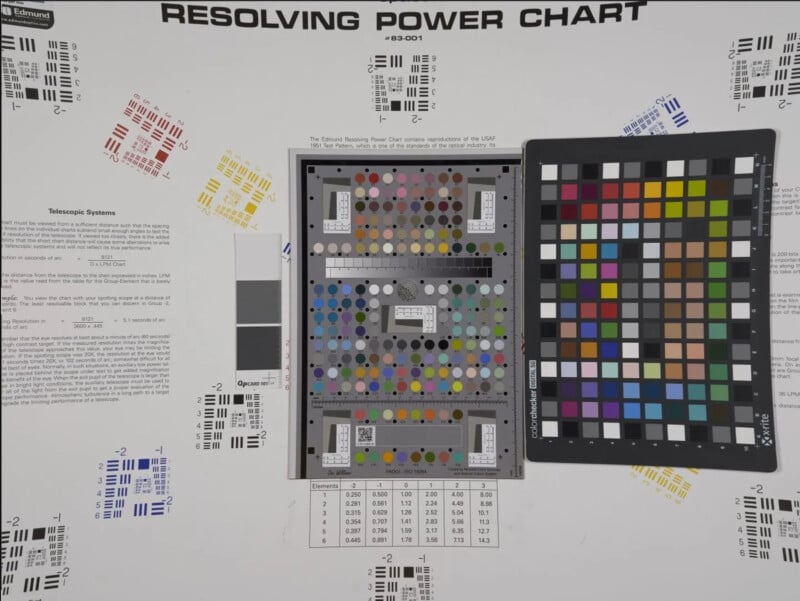100-Megapixel Camera Image Quality Shootout
![]()
There are many fantastic high-resolution cameras on the market, including multiple 100-megapixel medium-format cameras. But which is the best? That’s what the imaging experts at Capture Integration sought to determine in a detailed camera shootout.
However, determining which camera is best is a tall order. Fortunately, as Capture Integration’s Dave Gallagher explains, there are established industry standards the team can use to measure image quality for this shootout. The Federal Agency Digital Guidelines Initiative (FADGI) provides image creators and archivists with “a complex set of parameters for digitization purposes,” which Gallagher says “took the difficult prospect of image quality consistency and standardized it into a simple four-star rating system to compare output.”
“Don’t we wish we had this in other areas of photography?” Gallagher adds.
![]()
This shootout is much more than a fun experiment, though. The testing solves a significant headache for specialist camera retailers like Capture Integration. Many of its clients are in the Cultural Heritage capture market, where there is a dearth of comprehensive comparisons that will help customers pick the right system for their needs.
There are a couple of big reasons why this type of information previously hasn’t existed, including financial limitations and motivations for some in the cultural heritage space to keep details close to the vest, but Capture Integration put the time and money in.
“We can now proudly state that we have put in the effort to present the correct information to the cultural heritage market,” Gallagher explains.

The 100-Megapixel Competitors
The three camera systems entering the ring include the Phase One IQ3 100MP Digital Back on a Phase One XF camera body with the Schneider Kreuznach 80mm Blue Ring II lens, the Hasselblad X2D 100C with the XCD 80mm f/1.9, and the Fujifilm GFX 100S II and GF 80mm f/1.7 R WR portrait prime.
While all three medium-format cameras have 100-megapixel image sensors, the sensor sizes vary. The Phase One IQ3 100MP has a 53.7 x 40.4mm image sensor, while the X2D 100C and GFX 100S II feature smaller 43.8 x 32.9mm sensors. While these sensors are still considerably larger than a full-frame sensor (36 x 24mm), there is no substitute for a physically larger image sensor, all else equal.
As for why the IQ3 100MP and not the IQ4 150MP, Capture Integration says it would have been unfair to pit the relatively much more affordable Hasselblad and Fujifilm 100-megapixel cameras up against the larger 150MP sensor in the Phase One IQ4 series.
Each camera system was positioned to capture the testing targets at a native 400 pixels per inch, and the results were saved as a max-quality TIFF file and uploaded to Phase One’s NimbusQ∆ website for FADGI scoring. For cameras that offer pixel-shift capture, like the GFX 100S II, those results were also scored.
NimbusQ∆ evaluates the images across resolution, 16 different image quality categories, and determines whether the image meets FADGI 4 standards. The scores are then calculated on a scale of 100.
To ensure a level playing field, every possible variable was controlled, including white balance, lighting, and in-camera image processing settings. All lenses were shot at f/11, and all ISOs were set to 100. While one could split hairs about whether each lens performs at its best at the equalized f/11 aperture, it is essential to keep everything as consistent as possible for testing.
![]()
Which 100-Megapixel Camera Performs the Best?
Perhaps unsurprisingly, given the Phase One IQ3’s larger image sensor, it came out on top in testing. With a FADGI Single Shot Score of 97%, the system meets FADGI 4 standards and performs very well across nearly every category, dropping from four to three stars across only SFR10 and average color accuracy categories.
This camera lacks a multi-shot capture mode, unfortunately, but nonetheless excels in a single-shot environment. Capture Integration notes that the camera even scored 98% and 99% when using two different Rodenstock HR lenses, but given the relatively high cost of these lenses ($10,000 to $15,000), the team opted to stick with the “standard” lens for its final scoring.

Now, did the Phase One camera score better in the NimbusQ∆ software because of the Phase One partnership? Gallagher’s gut feeling is no, noting that the Phase One files genuinely looked superior across the board.
But does Capture One processing make the images better for NimbusQ∆ testing?
“This question is still up for debate,” Gallagher admits.
A 97% score is fantastic, but there is the elephant-sized dollar sign issue to consider. The tested Phase One IQ3 100MP system is built around a nearly decade-old camera, but it still costs $46,000 for the camera, digital back, relatively “cheap” 80mm Blue Ring lens, and additional gear needed to create a FADGI 4 Reproduction station.
Next up is the Hasselblad X2D 100C and XCD 80mm f/1.9 lens, which fails to meet FADGI 4 standards in single-shot mode but steps up to an impressive 91% score in multi-shot mode.


“Hasselblad historically has championed the advantages of multi shot backs and pixel shifting. Many of our clients were severely disappointed when they discontinued the Hasselblad H6D 400c multi shot digital system and gave the cultural heritage market fewer options,” Gallagher writes. “It sent them scrambling for expensive alternatives. And then in 2024 firmware version 4.0 gifted existing Hasselblad X2D users the ability to pixel shift again on their pre-existing systems.”
In Hasselblad’s case, the X2D 100C’s multi-shot functionality moves the sensor by one or one-half pixel at a time thanks to the camera’s in-body image stabilization, which enables the camera to capture each filter in the Bayer pattern for each of the sensor’s many pixels. This delivers more accurate color data for every pixel, minimal aliasing, and more definition. While it would be nice to meet FADGI 4 standards in single-shot mode, Hasselblad’s Phocus software makes capturing multi-shot images a breeze.
“And more importantly, Hasselblad allows Capture Integration to assemble a complete FADGI 4 system for less than half the price of the leading competitor in the Cultural Heritage Market,” Gallagher concludes.
Next up is Fujifilm, which outperforms the X2D 100C in single-shot mode but still fails to meet FADGI 4 standards. In fact, given significant issues with exposure consistency in a controlled environment, Capture Integration, a long-time champion of the GFX system for many applications, cannot recommend it for Cultural Heritage applications.

“This exposure inconsistency is occurring with both continuous and strobe capture, and with electronic shutter and mechanical shutter. And while we achieving passing scores on some of these tests, we don’t find a 10 point shift in exposure acceptable in the strict archival process,” Gallagher explains. Capture Integration tested six different GFX bodies and found the same issues each time.
Furthermore, the camera’s live view focus is subpar for digitizing and reproducing art, and its multi-shot capture mode is “flawed.”
“On one hand, the exposure consistency we have noticed is solved with 4-shot capture,” Gallagher remarks. However, the multi-shot images require varying degrees of overexposure compared to their single-shot counterparts. Additionally, the system necessitates Fujifilm’s Pixel Shift Combiner software, and the framing changes slightly in this mode. These are all surmountable for many types of photography, but headaches for reproduction and archiving.
Gallagher adds that the geometrical distortion and scaling in multi-shot mode “were like nothing we have ever seen before.” This means that the image scale changes across the frame, which is, again, a massive issue when reproducing artwork.

“Yes, we are as surprised and disappointed as you might have been to read these results. It would make sense that our commercial clients have not witnessed all of these anomalies in the field. When the sun is changing you won’t notice a 5 point shift in exposure,” Gallagher remarks.
“These problems truly only show up when tethered in a highly controlled environment. Again, while we achieve satisfactory FADGI standards on some Fujifilm files, it is disappointing to state that we cannot currently recommend any GFX camera system for Cultural Heritage workflow.”
Gallagher reiterates that many of its clients have loved the GFX camera for their work, including landscape, architecture, and commercial work, and none of the FADGI testing changes how excellent GFX cameras and lenses are for 99% of photographers. However, in this particular, rigorous controlled situation, the GFX fails to live up to industry standards.
You Can Meet FADGI 4 Standards for Much Less Than $100,000
Gallagher and the Capture Integration team conclude that Phase One’s digital imaging systems remain the leading capture device within the Cultural Heritage market. However, FADGI 4 standards can be satisfied for much less money using the Hasselblad X2D 100C in its multi-shot capture mode. As for Fujifilm, a company that has tried to make headway in the Cultural Heritage segment and genuinely makes fantastic medium-format digital cameras, Capture Integration says the GFX is currently a “poor choice for Cultural Heritage workflow.”
Capture Integration has all the medium-format cameras, lenses, and accessories necessary for Cultural Heritage or other high-end photographic applications, including Phase One, Hasselblad, and Fujifilm systems. They also have certified pre-owned equipment available for those looking to save some money on an upgraded system.
Image credits: Capture Integration. Header photo created using an asset licensed via Depositphotos.